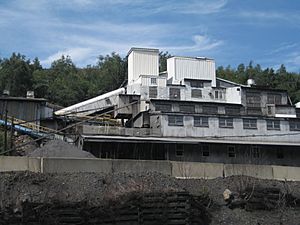Coal preparation plant facts for kids

A coal preparation plant (often called a CPP or wash plant) is a special factory where coal is cleaned and sorted. Think of it like a giant laundry and sorting facility for coal! Its main job is to remove unwanted materials like soil and rock from the coal. It also crushes the coal into different sizes, stores it, and gets it ready for transport by trains, barges, or ships.
The cleaner the coal, the better it is for many reasons. When waste material is removed, the coal has less ash when burned. This makes it more valuable and cheaper to transport because you're not paying to ship dirt and rocks.
Contents
What is a Coal Preparation Plant?
A coal preparation plant is a large industrial site designed to process raw coal that comes directly from a mine. This raw coal, often called "run-of-mine" (ROM) coal, contains a lot of impurities. These impurities can include dirt, rocks, and other minerals mixed in with the coal. The goal of the CPP is to transform this raw material into a clean, usable product that meets specific quality standards for customers.
Why Clean Coal?
Cleaning coal is very important for several reasons. First, it makes the coal more efficient when it's burned, for example, in power plants to create electricity. Cleaner coal produces less ash and pollution. Second, removing waste makes the coal lighter and more concentrated, which means it costs less to transport it to where it's needed. Imagine paying to ship a truck full of coal and half of it is just dirt! Cleaning the coal also increases its market value, as buyers prefer a higher quality product.
Crushing Coal: Making it Smaller
When coal first arrives at a preparation plant, it often comes in very large chunks. The first step in processing is usually crushing. Crushing machines break down these big pieces of coal into smaller, more manageable sizes. This makes it much easier to handle the coal and allows it to flow smoothly through the rest of the cleaning and sorting processes in the plant. There are different types of crushers, each designed to break coal in a specific way.
Screening Coal: Sorting by Size
After crushing, the coal goes through a process called screening. Imagine sifting sand through different-sized sieves; that's similar to what screens do with coal. Screens separate the coal particles into different size groups, or "grades." This is important because different industries need coal of specific sizes. For example, some power plants might need fine coal, while others prefer larger chunks. Special screens called "dewatering screens" are also used to remove water from the coal, making it drier and ready for the next steps. These screens can be static or vibrate to help the coal move through.
Gravity Separation: Floating Away the Waste
One of the cleverest ways coal is cleaned is through gravity separation. This method uses the fact that coal is lighter than the rocks and dirt mixed with it. In simple terms, the coal is put into a liquid (often water or a mixture of water and fine sand) where the lighter coal floats, and the heavier rocks and impurities sink. This allows the plant to easily separate the clean coal from the unwanted waste material. It's like how a log floats on water, but a rock sinks!
Smart Controls: Running the Plant Smoothly
Modern coal preparation plants use a lot of technology to work efficiently. This is where control and instrumentation comes in. Sensors and computers constantly measure things like how much coal is flowing, its density, the water levels, and even the amount of ash and moisture in the coal. This information is fed into a central control system, often using special computers called PLCs. These systems help operators monitor and adjust the plant's machinery, making sure everything runs smoothly and the coal is cleaned to the highest possible standards.
Images for kids








